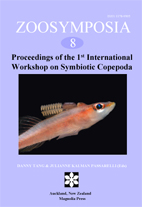Abstract
Asterocheres Boeck, 1859 is the most speciose genus within the copepod family Asterocheridae Giesbrecht, 1899. Its main hosts are sponges, cnidarians, bryozoans, and echinoderms. Among the latter there are records of Asterocheres associations with some species of the echinoid genus Eucidaris Pomel, 1883. Despite the wide distribution of Eucidaris tribuloides (Lamarck, 1883) in the coastal waters of Brazil, no records exist as yet of any copepod associated with this species. Asterocheres siphunculus sp. nov. is described herein based on samples collected from E. tribuloides sampled from two different sites off the coast of Salvador city, Bahia state, in northeastern Brazil. The new species shares a 20-segmented antennule with 20 congeners, but differs from them by having a very short siphon that reaches the insertion of the maxilla, a very wide rostrum that occupies the entire area between the antennules, and a pedigerous somite 4 with pointed and narrow posterolateral corners and a concave posterior margin.

